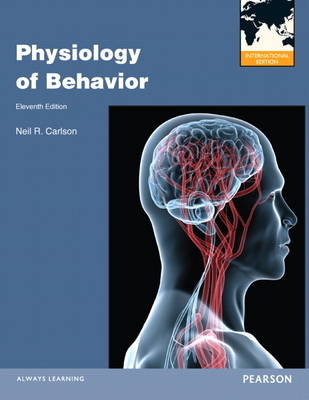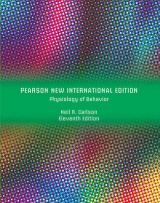
Physiology of Behavior
Pearson (Verlag)
978-0-205-87194-0 (ISBN)
- Titel erscheint in neuer
- Artikel merken
Thoughtfully organized, Physiology of Behavior provides a scholarly yet accessible portrait of the dynamic interaction between biology and behavior. Close collaboration between the author and a talented artist has resulted in beautiful, accurate, and pedagogically effective illustrations in every chapter.
No other author compares to Carlson when it comes to thoroughly updating research. This revision incorporates the latest discoveries in behavioral neuroscience, and includes over 400 new references. Integrated for the first time with MyPsychLab, featuring an interactive Virtual Brain, chapter study plans, flashcards, and other resources, Carlson's 11th edition offers students an immersive and engaging experience.
A better teaching and learning experience
This program will provide a better teaching and learning experience— for you and your students. Here’s how:
Personalize Learning - The new MyPsychLab delivers proven results in helping students succeed, provides engaging experiences that personalize learning, and comes from a trusted partner with educational expertise and a deep commitment to helping students and instructors achieve their goals.
Improve Critical Thinking — Section Summaries with Thought Questions help students test their understanding of the materials.
Engage Students — A close collaboration between the author and a talented artist has resulted in beautiful, accurate, and pedagogically effective illustrations in every chapter.
Explore Research — In light of the rapidly evolving field of behavioral neuroscience, over 400 new references are included in this edition.
Support Instructors — With resources such as Instructor’s Manual, Test Bank, highly visual PowerPoint Slides, and for the first time ever, the new MyPsychLab with ClassPrep, instructors have everything they need to teach behavioral neuroscience. All of these materials are available to be packaged with the text upon request.
Note: MyPsychLab does not come automatically packaged with this text. To purchase MyPsychLab, please visit www.mypsychlab.com or you can purchase a ValuePack of the text + MyPsychLab (at no additional cost). ValuePack ISBN-10: 0205889786 / ValuePack ISBN-13: 9780205889785.
I pursued my undergraduate studies at the University of Illinois. I had planned to study nuclear physics, but when I discovered in an introductory psychology course that psychology was really a science, I decided that was what I wanted to do. Before changing my major, I talked with several professors and visited their laboratories, and when I saw what physiological psychologists do, I knew that I had found my niche. I stayed on at Illinois and received my Ph.D. Then, after a two-year postdoctoral fellowship at the University of Iowa, I came to the University of Massachusetts, where I’ve been ever since. When I arrived at UMass I established a laboratory where I investigated the role of the limbic system in species-typical and learned behaviors, continuing work I had done at the University of Illinois. I received several Biomedical Research Support Grants and a research grant from NICHD. As I became more involved in textbook writing, I began to focus my attention more and more on this activity and on my teaching. I took the opportunity afforded by my first sabbatical leave to write the first edition of Physiology of Behavior. I very much enjoyed the experience, and this endeavor taught me much more about behavioral neuroscience. I was gratified with the positive response of my students and of the colleagues who adopted the book. The pleasure provided by this response and by the enjoyment of keeping up with the literature and writing about it has kept me going for 11 editions. (I have no plans to stop writing.) I retired from UMass in the fall of 2004 but continue to keep up with developments in the field of behavioral neuroscience and revise my book. The Psychology Department has kindly let me keep an office at the university, which makes it easier for me to continue interacting with my former colleagues. My interests outside of writing include spending time with our family, traveling, fly fishing, skiing, and flying our small airplane." --Neil Carlson
In this Section:
1. Brief Table of Contents
2. Full Table of Contents
1. BRIEF TABLE OF CONTENTS
Chapter 1 Introduction
Chapter 2 Structure and Functions of Cells of the Nervous System
Chapter 3 Structure of the Nervous System
Chapter 4 Psychopharmacology
Chapter 5 Methods and Strategies of Research
Chapter 6 Vision
Chapter 7 Audition, the Body Senses, and the Chemical Sense
Chapter 8 Control of Movement
Chapter 9 Sleep and Biological Rhythms
Chapter 10 Reproductive Behavior
Chapter 11 Emotion
Chapter 12 Ingestive Behavior
Chapter 13 Learning and Memory
Chapter 14 Human Communication
Chapter 15 Neurological Disorders
Chapter 16 Schizophrenia and the Affective Disorders
Chapter 17 Anxiety Disorders, Autistic Disorder, Attention-Deficit/Hyperactivity
Disorder, and Stress Disorders
Chapter 18 Drug Abuse
2. FULL TABLE OF CONTENTS
Chapter 1 Introduction
Understanding Human Consciousness: A Physiological Approach
The Nature of Physiological Psychology
Natural Selection and Evolution
Ethical Issues In Research With Animals
Careers in Neuroscience
Strategies for Learning
Chapter 2 Structure and Functions of Cells of The Nervous System
Cells of the Nervous System
Communication within a Neuron
Communication between Neurons
Chapter 3 Structure of the Nervous System
Basic Features of the Nervous System
The Central Nervous System
The Peripheral Nervous System
Chapter 4 Psychopharmacology
Principles Of Psychopharmacology
Sites Of Drug Action
Neurotransmitters and Neuromodulators
Chapter 5 Methods and Strategies of Research
Experimental Ablation
Recording And Stimulating Neural Activity
Neurochemical Methods
Genetic Methods
Chapter 6 Vision
The Stimulus
Anatomy of the Visual System
Coding Of Visual Information in the Retina
Analysis of Visual Information: Role of The Striate Cortex
Analysis of Visual Information: Role of The Visual Association Cortex
Chapter 7 Audition, the Body Senses, and the Chemical Sense
Audition
Vestibular System
Somatosenses
Gustation
Olfaction
Chapter 8 Control of Movement
Muscles
Reflexive Control of Movement
Control of Movement by the Brain
Chapter 9 Sleep and Biological Rhythms
A Physiological and Behavioral Description Of Sleep
Disorders of Sleep
Why Do We Sleep?
Physiological Mechanisms of Sleep And Waking
Biological Clocks
Chapter 10 Reproductive Behavior
Sexual Development
Hormonal Control of Sexual Behavior
Neural Control of Sexual Behavior
Parental Behavior
Chapter 11 Emotion
Emotions as Response Patterns
Communication of Emotions
Feelings of Emotions
Chapter 12 Ingestive Behavior
Physiological Regulatory Mechanisms
Drinking
Eating: Some Facts about Metabolism
What Starts A Meal?
What Stops A Meal?
Brain Mechanisms
Obesity
Anorexia Nervosa/Bulimia Nervosa
Chapter 13 Learning and Memory
The Nature of Learning
Synaptic Plasticity: Long-Term Potentiation and Long-Term Depression
Perceptual Learning
Classical Conditioning
Instrumental Conditioning
Relational Learning
Chapter 14 Human Communication
Speech Production and Comprehension: Brain Mechanisms
Disorders of Reading and Writing
Chapter 15 Neurological Disorders
Tumors
Seizure Disorders
Cerebrovascular Accidents
Disorders of Development
Degenerative Disorders
Disorders Caused By Infectious Diseases
Chapter 16 Schizophrenia and the Affective Disorders
Schizophrenia
Major Affective Disorders
Chapter 17 Anxiety Disorders, Autistic Disorder, Attention-Deficit/Hyperactivity Disorder, and Stress Disorders
Anxiety Disorders
Autistic Disorder
Attention-Deficit/Hyperactivity Disorder
Stress Disorders
Chapter 18 Drug Abuse
Common Features of Addiction
Commonly Abused Drugs
Heredity and Drug Abuse
Therapy for Drug Abuse
| Erscheint lt. Verlag | 10.2.2012 |
|---|---|
| Sprache | englisch |
| Maße | 212 x 276 mm |
| Gewicht | 1430 g |
| Themenwelt | Geisteswissenschaften ► Psychologie ► Psychoanalyse / Tiefenpsychologie |
| ISBN-10 | 0-205-87194-1 / 0205871941 |
| ISBN-13 | 978-0-205-87194-0 / 9780205871940 |
| Zustand | Neuware |
| Informationen gemäß Produktsicherheitsverordnung (GPSR) | |
| Haben Sie eine Frage zum Produkt? |
aus dem Bereich



